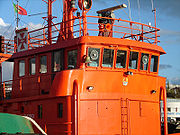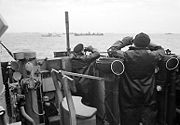.gif)
Bridge (ship)
Encyclopedia


Ship
Since the end of the age of sail a ship has been any large buoyant marine vessel. Ships are generally distinguished from boats based on size and cargo or passenger capacity. Ships are used on lakes, seas, and rivers for a variety of activities, such as the transport of people or goods, fishing,...
is the room or platform from which the ship can be commanded. When a ship
Ship
Since the end of the age of sail a ship has been any large buoyant marine vessel. Ships are generally distinguished from boats based on size and cargo or passenger capacity. Ships are used on lakes, seas, and rivers for a variety of activities, such as the transport of people or goods, fishing,...
is underway the bridge is manned by an OOW (officer of the watch) aided usually by an AB
Able Seaman (rank)
In the British Royal Navy in the middle of the 18th century, the term able seaman referred to a seaman with at least two years' experience at sea...
(able seaman) acting as lookout. During critical manoeuvres the captain
Captain (naval)
Captain is the name most often given in English-speaking navies to the rank corresponding to command of the largest ships. The NATO rank code is OF-5, equivalent to an army full colonel....
will be on the bridge supported, perhaps, by an OOW as an extra set of hands, an AB
Able Seaman (rank)
In the British Royal Navy in the middle of the 18th century, the term able seaman referred to a seaman with at least two years' experience at sea...
on the wheel and sometimes a pilot
Maritime pilot
A pilot is a mariner who guides ships through dangerous or congested waters, such as harbours or river mouths. With the exception of the Panama Canal, the pilot is only an advisor, as the captain remains in legal, overriding command of the vessel....
if required.
Wheelhouse
Wheelhouse
Wheelhouse or Wheel-house may refer to a number of topicsIn nautical context*The location of the steering wheel of a boat or ship**Bridge **Pilothouse...
s are the small enclosed parts of a bridge which historically held the ship's steering wheel. Today, ship bridges do not have a separate wheelhouse.
Evolution
Traditionally, sailing shipSailing ship
The term sailing ship is now used to refer to any large wind-powered vessel. In technical terms, a ship was a sailing vessel with a specific rig of at least three masts, square rigged on all of them, making the sailing adjective redundant. In popular usage "ship" became associated with all large...
s were commanded from the quarter deck, aft of the mainmast. With the arrival of paddle steamer
Paddle steamer
A paddle steamer is a steamship or riverboat, powered by a steam engine, using paddle wheels to propel it through the water. In antiquity, Paddle wheelers followed the development of poles, oars and sails, where the first uses were wheelers driven by animals or humans...
s, engineers required a platform from which they could inspect the paddle wheels and where the captain
Captain (nautical)
A sea captain is a licensed mariner in ultimate command of the vessel. The captain is responsible for its safe and efficient operation, including cargo operations, navigation, crew management and ensuring that the vessel complies with local and international laws, as well as company and flag...
's view would not be obstructed by the paddle houses. A raised walkway, literally a bridge, connecting the paddle houses was therefore provided. When the screw propeller superseded the paddle wheel, the bridge was retained.
Traditionally, commands would be passed from the senior officer on the bridge to stations dispersed throughout the ship, where physical control of the ship was exercised, as technology did not exist for the remote control of e.g. steering or machinery. Helm orders would be passed to an enclosed wheel house, where the coxswain
Coxswain
The coxswain is the person in charge of a boat, particularly its navigation and steering. The etymology of the word gives us a literal meaning of "boat servant" since it comes from cox, a coxboat or other small vessel kept aboard a ship, and swain, which can be rendered as boy, in authority. ...
or helmsman
Helmsman
A helmsman is a person who steers a ship, sailboat, submarine, or other type of maritime vessel. On small vessels, particularly privately-owned noncommercial vessels, the functions of skipper and helmsman may be combined in one person. On larger vessels, there is a separate officer of the watch,...
operated the ship's wheel
Ship's wheel
A ship's wheel is the modern method of adjusting the angle of a boat or ship's rudder in order to cause the vessel to change its course. Together with the rest of the steering mechanism it forms part of the helm. It is typically connected to a mechanical, electric servo, or hydraulic system...
. Engine commands would be relayed to the engineer in the engine room
Engine room
On a ship, the engine room, or ER, commonly refers to the machinery spaces of a vessel. To increase the safety and damage survivability of a vessel, the machinery necessary for operations may be segregated into various spaces, the engine room is one of these spaces, and is generally the largest...
by an engine order telegraph
Engine order telegraph
An engine order telegraph or E.O.T., often also chadburn, is a communications device used on a ship for the pilot on the bridge to order engineers in the engine room to power the vessel at a certain desired speed...
, which displayed the captain's orders on a dial. The engineer would ensure that the correct combination of steam pressure and engine revolutions were applied. The bridge was often open to the elements, therefore a weatherproof pilot house could be provided, from where a pilot (traditionally, the pilot was the ship's navigating officer) could issue commands from shelter.

Iron
Iron is a chemical element with the symbol Fe and atomic number 26. It is a metal in the first transition series. It is the most common element forming the planet Earth as a whole, forming much of Earth's outer and inner core. It is the fourth most common element in the Earth's crust...
, and later steel
Steel
Steel is an alloy that consists mostly of iron and has a carbon content between 0.2% and 2.1% by weight, depending on the grade. Carbon is the most common alloying material for iron, but various other alloying elements are used, such as manganese, chromium, vanadium, and tungsten...
, ships also required a compass platform. This was usually a tower, where a magnetic compass could be sited far away as possible from the ferrous interference of the hulk of the ship. Depending upon the design and layout of a ship, all of these terms can be variously interchangeable. Many ships still have a flying bridge
Flying bridge
A flying bridge is a area on top of, or at the side of, a ship's pilothouse, or closed bridge, that serves as an operating station for the ship's officers in good weather or when maneuvering in port, where good views along the ship sides are important...
, a platform atop the pilot house, open to weather, containing a binnacle
Binnacle
A binnacle is a waist-high case or stand on the deck of a ship, generally mounted in front of the helmsman, in which navigational instruments are placed for easy and quick reference as well as to protect the delicate instruments. Its traditional purpose was to hold the ship's magnetic compass,...
and voice tubes to allow the conning officer to direct the ship from a higher position during fair weather conditions.
Larger ships, particularly warship
Warship
A warship is a ship that is built and primarily intended for combat. Warships are usually built in a completely different way from merchant ships. As well as being armed, warships are designed to withstand damage and are usually faster and more maneuvrable than merchant ships...
s, often had a number of different bridges. A navigation bridge would be used for the actual conning of the ship. A separate admiral's bridge could be provided in flagship
Flagship
A flagship is a vessel used by the commanding officer of a group of naval ships, reflecting the custom of its commander, characteristically a flag officer, flying a distinguishing flag...
s, where the admiral
Admiral
Admiral is the rank, or part of the name of the ranks, of the highest naval officers. It is usually considered a full admiral and above vice admiral and below admiral of the fleet . It is usually abbreviated to "Adm" or "ADM"...
could exercise strategic control over his fleet without interfering with the Captain's tactical command of the vessel. In older warships, a heavily-armoured conning tower
Conning tower
A conning tower is a raised platform on a ship or submarine, often armored, from which an officer can con the vessel; i.e., give directions to the helmsman. It is usually located as high on the ship as practical, to give the conning team good visibility....
was often provided, where the vital command staff could be located under protection to ensure that the ship could be commanded and fought under fire.
Modern advances in remote control equipment have seen progressive transfer of the actual control of the ship to the bridge. The wheel and throttle
Throttle
A throttle is the mechanism by which the flow of a fluid is managed by constriction or obstruction. An engine's power can be increased or decreased by the restriction of inlet gases , but usually decreased. The term throttle has come to refer, informally and incorrectly, to any mechanism by which...
s can be operated directly from the bridge, controlling often-unmanned machinery spaces. Aboard modern warships it is common that actual commanding is carried out on the bridge while weapon systems are controlled from a room usually deep inside the vessel. This also enables a redundant setup in which the vessel is still able to fight in case one of the command instances has been hit or destroyed.
See also
- Deck departmentDeck departmentThe Deck Department is an organizational unit aboard naval and merchant ships. A Deck Officer is an officer serving in the deck department.-Merchant shipping:...
- Engineering department

